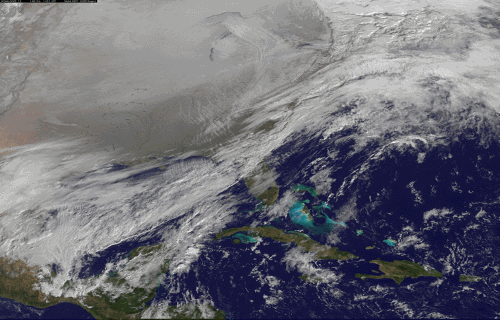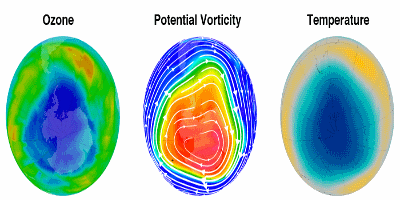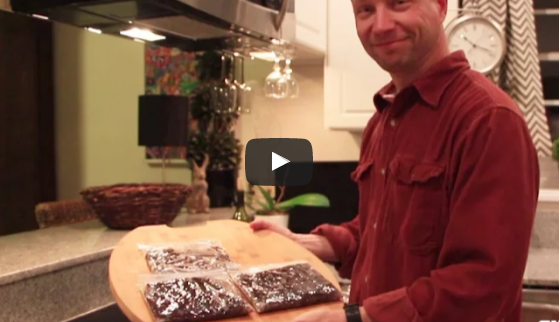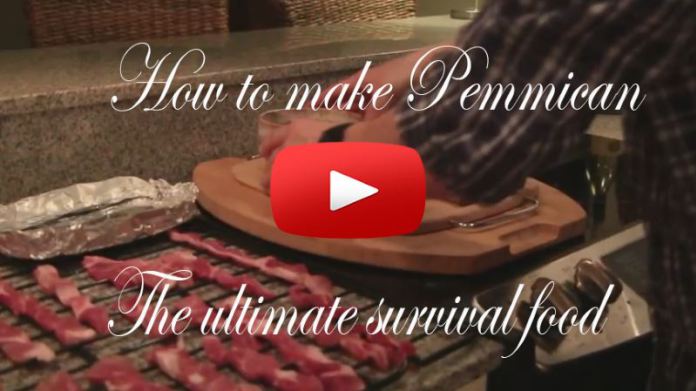Scientists Are Predicting Polar Vortex To Bring Big Freeze And Coldest Winter For Five Years
Polar vortex enters Northern U.S.
The stratospheric polar vortex is a large-scale region of air that is contained by a strong west-to-east jet stream that circles the polar region. This jet stream is usually referred to as the polar night jet. The polar vortex extends from the tropopause (the dividing line between the stratosphere and troposphere) through the stratosphere and into the mesosphere (above 50 km). Low values of ozone and cold temperatures are associated with the air inside the vortex.
The stratospheric polar vortex shows quite a bit of day-to-day variability. This variability is caused by weather systems or large-scale waves that move upward from the troposphere into the stratosphere. In the left image , we see some undulations along the edge of the polar vortex, but the vortex is generally centered on the North Pole. Two weeks later we see the center of the polar vortex pushed away from the North Pole. On a constant latitude circle, PV values are high in the eastern hemisphere and low in the western hemisphere. This is referred to as a wave-1 pattern . The wave-1 pattern develops in the troposphere and moves upward (propagates) into the stratosphere.
These stratospheric waves are forced by the large-scale mountain systems and the land-sea contrasts between the continents and oceans. During the northern winter, these waves are continuously forming and moving upward into the stratosphere. The waves can “break”, much like the waves on a beach. These wave-breaking events erode the vortex and keep the polar region warmer and ozone amounts higher. Often, parts of the polar vortex are pulled away from the main vortex. The image on the right shows this, where a large piece of the polar vortex was pulled away from the main vortex (green colored material at the bottom of the image). A comparison between the middle and right images also shows a slight contraction of the polar vortex because of these waves.
Vortex breakup
The polar vortex is a winter phenomena. It develops as the sun sets over the polar region and temperatures cool. During the spring, the sun rises and the absorption of solar radiation by ozone begins to heat the polar stratosphere. This heating eventually causes the vortex to disappear along with the polar night jet. However, this process is helped along by planetary-scale waves that propagate up from the troposphere. This wave event that drives the vortex breakup (or final warming) acts to also increase the temperature of the polar region and ozone levels. We mark the day of the vortex breakup when the winds around the vortex edge decrease below a particular value (about 15 m s -1on the 460 K potential temperature surface).
Health officials have issued a desperate plea to the public, urging them to wrap up warm and turn to pharmacies at the first sign of illness, amid “enormous pressure” on casualty departments. Forecasts suggest could be facing the coldest winter for five years, with average minimum temperatures.
Research has also shown that people with conditions such as heart disease, lung problems including asthma, and dementia are much more likely to die in winter.
Cold indoor or outdoor temperatures increases blood pressure, which heightens the risk of heart failure, kidney disease and stroke.
It also makes the blood more likely to clot, raising the risk of heart attack and stroke, and reduces the lung’s ability to fight off infection.
The senior doctor advised keeping homes warm, with regular hot drinks and meals, and urged people to see their pharmacist at the first sign of health problems.
Types of winter food storage preservation methods
Originally appeared homepreservingbible
A root cellar is the classic winter storage cellar and existed when houses had unfinished basements with dirt floors. This (lack of) construction made the cellar cool, drafty, and relatively humid. The open, non-insulated root cellar had adequate airflow that despite high humidity, discouraged condensation on the walls. In contrast, a cold room is a finished, but unheated room in some modern homes.
A cold room, unlike the root cellar, is a finished but unheated room in an otherwise warm, dry basement. The basic difference between a root cellar and a basement cold room is the construction. If you have a cold room, or a basement that is partly below ground, you may be able to create a usable cold room. The trick is to design the room as if it is actually an exterior space. The key element of the construction is to insulate the ceiling and interior walls, leave the exterior walls uninsulated, add a vapor barrier on the warm side of the house, and install an insulated exterior door with weather stripping to the cold room. Most importantly, add two screened, adjustable vents that provide a (high) warm-air outlet and (low) cool-air intake. Ensure the floor is a porous material (dirt, cement, or composite deck material are better than wood or linoleum). Finally, build shelving away from the walls to promote air circulation within the room.
Any type of indoor cellar requires a method to control air temperature and relative humidity. Depending on the type of food to be stored, a root cellar or a cold room needs cool temperatures, ranging from 32°F to 60°F, and higher than average humidity—between 60 to 90 percent relative humidity (RH).
Buried containers make a convenient root cellar or cold space for winter food storage, especially root crops. The container should be new or clean, and should not have previously held nonfood items. Suitable containers include new metal or plastic garbage cans and plastic storage bins. Drill holes in the bottom of the container for drainage. Locate the container in an area convenient to your house, but away from garages and car fumes. Dig a hole just large enough to hold the container, with at least 2 inches sticking out above ground level. Load the container with layers of vegetables, separated by straw. Cover the top of the container with 1 to 2 feet of insulating material.
Makeshift cellars are other simple, easy ways to provide additional storage of seasonal crops through winter:
- Basement utility rooms, especially those with a furnace, tend to be warm and dry. This type of room is suitable for some types of vegetables such as winter squashes and onions, as well as dried and canned foods.
- Attic rooms, if they are warm and dry, are well suited to onions, dried vegetables, and dried herbs. If the attic becomes very cold in severe weather, you will need to rotate food to another location. By summertime, if the weather turns hot and humid, winter stored food should be used up.
- An extra energy-efficient refrigerator, while requiring the use of electricity, can also provide a method for long-term storage of locally grown seasonal fruits and vegetables.
Regardless of the type of food storage method used, be sure to monitor the storage environment using a thermometer, as well as a hygrometer that measures relative humidity. Check the produce at least once a month for possible signs of wilting or decay. At least once a year, thoroughly clean and sanitize any type of root cellar or food storage area.
Proper temperature and humidity, and annual cleaning are crucial to reliable long-term storage, and regular monitoring will help you maintain the quality of your food for an entire season of delicious eating.
RELATED : EMP Proof Generator: Two Kinds You Can Build Yourself
Types of produce for winter food storage
The tradition of cellaring takes advantage of cold weather, which provides a natural winter food storage environment. In more temperate locations, storage areas need to be given more thought. Either way, the storage methods you use must provide a controlled environment for the types of foods you wish to keep. If you are new to cellaring, you may find that cabbages, onions, potatoes, and root crops are the easiest types of produce to master. If you grow your own vegetables, plant seed varieties recommended for long-term storage. Harvest vegetables early in the morning, on a cold day.
Before you store any produce, sort it for quality. When selecting produce to be stored, always choose firm, mature, unblemished fruits and vegetables, and handle them carefully. Never store any overripe, damaged, or decaying produce in a food storage area; it can contaminate other items if stored nearby. Immediately use or compost overripe produce instead of placing in any type of cellar.
Tips for successful winter food storage: To preserve fresh fruit and vegetable produce successfully, it helps to understand the difference between maturity and ripeness. Maturity means the produce will ripen and become ready to eat after you pick it. Ripeness occurs when the color, flavor, and texture is fully developed. Ripe produce is best for cellaring or cold food storage methods, as well as for fresh eating, drying, or freezing.
What happens if we lose power indefinitely — foods that require freezing or refrigeration for long term storage are going to go bad? Emergency food storage in advance will be the only way to feed yourself and your family.
Most produce is best stored in mesh bags, baskets, or other containers that allow for plenty of air circulation. Place mature produce gently in clean containers without sharp edges. Note that some produce, such as potatoes and onions have very different storage requirements. Potatoes and onions, along with most types of fruits, don’t make good neighbors in a food storage cellar. Here is a summary of the storage requirements for popular winter vegetables:
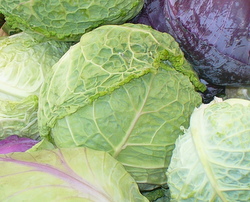 Cabbages keep best when you store it in the garden with heavy mulching, or in an outdoor building hung upside down by their roots from hooks. Cabbage gives off ethylene gas, so do not store cabbage indoors; the odor will fill the house. Cabbage prefers cold (32°F to 40°F), humid (80 to 90 percent RH) conditions.
Cabbages keep best when you store it in the garden with heavy mulching, or in an outdoor building hung upside down by their roots from hooks. Cabbage gives off ethylene gas, so do not store cabbage indoors; the odor will fill the house. Cabbage prefers cold (32°F to 40°F), humid (80 to 90 percent RH) conditions.- Onions and garlic should be conditioned for long storage by “curing” or drying in a well-ventilated place (such as an attic, open shed, or covered porch) for 2 to 3 weeks, or until their outer skins make a rustling sound, indicating they are sufficiently dry for storage. Medium-size red or yellow onions keep longer than large, white, or sweet varieties. Onions and garlic prefer cool (40°F to 50°F), dry (60 to 70 percent RH) rooms. If you garden, onions and garlic (as well as leeks) can also be stored in-ground for several weeks, and can withstand light frosts (to 34°F) with heavy mulching.
- Potatoes should be conditioned for long storage by “curing”. To prepare potatoes for curing, sort and remove any damaged or suspect (soft) potatoes for immediate use. Place firm, unblemished potatoes in a single layer, in the dark (in slightly open paper sacks or loosely covered with newspaper), at 45°F to 60°F for 2 weeks. After curing, store potatoes in a cold (32°F to 40°F), dry (60 to 70 percent RH) location. Store potatoes in complete darkness, such as inside paper bags, covered wooden boxes, tin pails, or buried in dry sand. Sprouting indicates the potatoes are too warm, or are stored next to produce such as onions or apples.
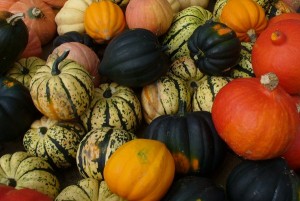 Pumpkins and winter squashes can be harvested after the vines are killed by a frost. Leave stems on during storage to protect fruit against disease. The best way to store winter squashes is in a cool to warm (40°F to 60°F), dry (60 to 70 percent RH) room. Attics, closets, or near a basement furnace can be excellent alternative locations. Place them individually on shelves or hung in mesh bags.
Pumpkins and winter squashes can be harvested after the vines are killed by a frost. Leave stems on during storage to protect fruit against disease. The best way to store winter squashes is in a cool to warm (40°F to 60°F), dry (60 to 70 percent RH) room. Attics, closets, or near a basement furnace can be excellent alternative locations. Place them individually on shelves or hung in mesh bags.- Root crops, including beets, carrots, celeriac, horseradish, parsnips, rutabagas, salsifies, turnips, and winter radishes, may be stored in-ground for several weeks, and can withstand light freezing (to 28°F) with heavy mulching. You can leave horseradish, parsnip, and salsify in the ground, well mulched until spring; they become sweet in very cold temperatures. Rutabagas, turnips, and winter radishes give off strong odors, so don’t store them indoors. In the cellar, store only beets, carrots, horseradish, parsnips, and salsifies. To store in the cellar, cut off the tops, leaving a 1-inch stem, and place in baskets or boxes. To optimize moisture in dry storage rooms, layer the crops with sand or sphagnum moss. Root crops prefer cold (32°F to 40°F), very humid (80 to 90 percent RH or more) conditions.
- Citrus fruits last longest when stored in cool (40°F to 50°F), dry (60 to 70 percent RH) conditions, in baskets or mesh bags to maximize airflow and prevent mold growth. Oranges can be stored close to freezing (32°F to 34°F).
- Pome fruits, like apples and pears, need to be stored as near freezing (32°F) as possible, in very humid (80 to 90 percent RH or more) conditions. Layer in sand, sawdust, or sphagnum moss; pack into well-ventilated plastic bags; or wrap fruits individually in tissue paper and layer in boxes. If you use plastic bags, routinely examine the bags for condensation; immediately air out bags with visible moisture, or the crop can quickly become moldy and inedible. Apples and pears give off ethylene gas; you may store them together, but away from other crops.
Disaster preparation has received a lot of attention in the recent past. In fact, people who live in every corner of the world prepare for various disasters such as famine and war. Some of them even prepare for zombies. It is always better to prepare to face disasters as they can hit us at unexpected times. However, it should be done according to a plan. That’s where The Lost Ways comes into play. This guide follows a scientific approach to help people prepare for disasters. In fact, it would let people know about the secret methods followed by the ancestors to survive disasters. They include a variety of disasters such as droughts, diseases, financial crisis, wars, famines and everything else life threw at them. For More Information About The Lost Ways Survival Guide Click Here
Other useful resources:
The Lost Ways (Learn the long forgotten secrets that helped our forefathers survive famines,wars,economic crisis and anything else life threw at them)
Survival MD (Best Post Collapse First Aid Survival GuideEver)
Backyard Innovator (A Self Sustaining Source Of Fresh Meat,Vegetables And Clean Drinking Water)
Blackout USA (EMP survival and preparedness)
Conquering the coming collapse (Financial advice and preparedness )
Liberty Generator (Build and make your own energy source)
Backyard Liberty (Easy and cheap DIY Aquaponic system to grow your organic and living food bank)
Bullet Proof Home (A Prepper’s Guide in Safeguarding a Home )
Family Self Defense (Best Self Defense Strategies For You And Your Family)
Survive Any Crisis (Best Items To Hoard For A Long Term Crisis)
Survive The End Days (Biggest Cover Up Of Our President)
Drought USA (Discover The Amazing Device That Turns Air Into Water)

